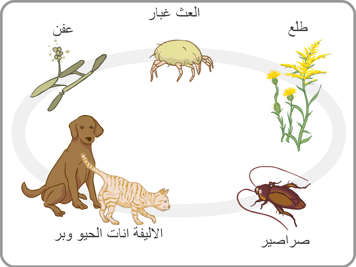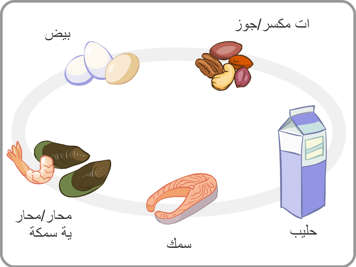ما هي الحساسية؟
يحمينا الجهاز المناعي من المواد الضارة، مثل الفيروسات والبكتيريا. الحساسية هي نوع من استجابة مناعية قوية لمادة غير ضارة لمعظم الناس. هذه المادة تعرف بالمستأرجات (مواد مثيرة للحساسية).
بالنسبة للاطفال الذي لديهم حساسية، يتفاعل الجهاز المناعي للجسم بإفراط ويعامل المستأرجات باعتبارها كغازي. هذا ينتج اعراض من انزعاج خفيف الى ضائقة شديدة.
ان الاضطرابات الحساسية، بما في ذلك الحساسية للطعام، هي من الامور الشائعة في مرحلة الطفولة. ويعاني أشخاص اكثر من حساسية مفرطة للطعام. والحساسية المفرطة للطعام هي احدى الاعراض الكريهة الناجمة عن الطعام. وهذا النوع من الحساسية ليس له علاقة بالجهاز المناعي. وكثير من الاطفال الذين يعانون من الحساسية يعانون ايضاً من مرض الربو. لمزيد من المعلومات، يرجى قراءة الربو. {رابط}
انواع المستأرجات
المستأرجات الشائعة المنقولة بالهواء

- عث الغبار. هذا الحشرات الصغيرة تعيش في الاماكن الحارة والرطبة والمليئة بالغبار في منزلك. هذه الحشرات تاكل الجلد الميت. ونفاياتها هي السبب الرئيسي لأمراض الحساسية والربو.
- الطلْع من الزهور والنباتات الاخرى.
- العفن
- وبر الحيوانات الاليفة. خلايا الجلد الميت من الحيوانات الاليفة
- الصراصير
حساسية الطعام الاكثر شيوعاً هي ما يلي:

- الفول السوداني (الفستق)
- شجر الجوز مثل البندق والجوز واللوز والكاجو
- البيض
- حليب البقر هو المسبب الاكثر شيوعاً لحساسية الطعام.
الاسماك والقشريات والرخويات هي ايضاً مسبب شائع للحساسية.
يمكن ان تؤدي حتى كميات قليلة من هذه الاطعمة الى الحساسية المفرطة في بعض الاطفال الشديدي الحساسية. التَأق (تَظَاهرات شديدة وفورية للحساسية) هو النوع الاكثر حدة من الحساسية (انظر ادناه). المستأرجات يمكن ايضاً ان تكون مخبأة في اطباق الطعام الشائعة للحفلات مثل الكعك والكيك والسكريات، او غيرها من الاطعمة. اسأل دائماُ الطاهي او المضيف ما إذا كانت اطباق الاطعمة تحتوي على مواد تسبب حساسية طفلك.
مستأرجات اخرى شائعة
- لسعات الحشرات
- الادوية
- المواد الكيميائية
علامات واعراض الحساسية
التفاعلات الأرجية تختلف في شدتها من حساسية الى اخرى ومن طفل الى آخر. والمكان الذي تعيش فيه يمكن ايضاً ان يؤثر على نوع وشدة الحساسية.
تتفاوت اعراض الحساسية، ولكن قد تشمل ما يلي:
- مشاكل في التنفس
- حرق، وتمزق، او حكة في العيون
- التهاب الملتحمة (عيون حمراء ومنتفخة)
- السعال
- الشَرَى (انتفاخات ناتئة حمراء تسبب الحكة)
- حكة في الانف والفم والحلق والجلد، او اي منطقة اخرى
- سيلان الانف
- الطفح الجلدي
- الازيز
- تورم حول الوجه او الحلق
- صدمة
المستأرجات المحمولة جواً
عادة ما تسبب المستأرجات المحمولة جواً العطس وحكة في الانف او الحلق، واحتقان الانف، واحمرار وحكة في العيون، والسعال. ويكون لدى بعض الاطفال ايضاً ازيز وضيق في التنفس.
مستأرجات الطعام ولدغ الحشرات
سوف تعتمد استجابة طفلك لحساسية الطعام او لدغ الحشرات على درجة الحساسية للطعام او الحشرة. يمكن ان تشمل الاعراض ما يلي:
- حكة في الفم والحلق عند ابتلاعه الطعام
- الشَرَى
- طفح يشبه الاكزيما
- سيلان وحكة الانف
- صعوبة في التنفس
- تورم حول الوجه او الحلق
- الاصابة بصدمة
الاسباب
المستأرجات قد تأتي بالتلامس مع الجلد، او بتنفسها، اكلها، او حقنها.
عندما يكتشف الجسم المستأرجات، يعطي اشارة للجهاز المناعي لإنتاج اجسام مضادة تدعى غلوبيولين مناعي إي. هذه الاجسام المضادة تسبب بعض الخلايا في الجسم لإطلاق مواد كيميائية تسمى الهيستامين. الهيستامين يسبح في مجرى الدم للدفاع ضد هذه المادة الغازية او المستأرجات.
تعتمد ردة فعل طفلك للحساسية على اي جزء من الجسم قد تعرّض للحساسية. الامر الاكثر شيوعاً هو ان الحساسية تؤثر على عيون الطفل والانف والحنجرة والرئتين او الجلد.
التأق (انافيلاكسس) اي تظاهرات شديدة وفورية للحساسية
قد تكون بعض انواع الحساسية، حساسية الطعام بوجه خاص، شديدة وتهدد الحياة. إذا كانت الحساسية للمستأرجات بالغة، قد يختبر طفلك تَأق في غضون ثوان من التعرض للمستأرجات.
التأق هو دفاع الجسم السريع والقوي كرد فعل على المستأرجات. هذا الرد يمكن ان يكون قوياً لدرجة انه يمكن ان يكون خطيراً. الاضداد التي تم اطلاقها خلال التأق قد تسبب صعوبة في التنفس، تورم، او هبوط في ضغط الدم (الصدمة).
يمكن ان يوقف العلاج السريع بالدواء الذي يدعى اپينَافين (يلفظ بالانكليزية: اپي نا فين) هذه العملية وينقذ حياة طفلك. هذا الدواء معروف باسم اپي-پن (قلم اپي). التأق هو حالة طارئة. يحتاج طفلك الى الذهاب الى المستشفى على الفور.
ما يمكن ان يفعله طبيب طفلك للحساسية
سوف يجري طبيب طفلك عادة فحص بدني لطفلك. وسوف يطلب مقدم الخدمات الصحية بعد ذلك تاريخ حساسية طفلك، ويطلب وصفاً لأعراض الحساسية. قد يتم عندها فحص طفلك. ويمكن ان يشمل ذلك فحص الجلد، وفحص الدم، وتصوير الصدر بالاشعة السينية، واختبار وظائف الرئة، او فحص تحمل الرياضة البدنية. سيقوم الطبيب بالتشخيص بناءً على نتائج الفحص. ثم سيجتمع الطبيب معك ومع طفلك في وقت لاحق لمناقشة النتائج.
التحضير لموعدك
قد يحتاج طفلك الى التوقف عن استخدام الدواء لفترة معينة من الوقت قبل فحص الحساسية. ويمكن ان تشمل هذه الادوية مضادات الحساسية والحبوب الاخرى لعلاج دوار الحركة. اسأل الطبيب إذا كان طفلك يجب ان يتوقف عن تناول الادوية قبل الزيارة.
رعاية طفلك الذي يعاني من الحساسية في المنزل
عالج طفلك المصاب بالحساسية بالادوية التي نصح بها طبيب طفلك. إذا كان طفلك يعاني من طفح جلدي، قد تخفف غسول الكالامين او الكمّادات الباردة الألم والانزعاج. يمكن ان تخفف مضادات الهيستامين (مثل بينادريل او كلور-تريپولن) الالم او الحكة. قد تجعل هذه الادوية طفلك ينعس.
اذا كان طفلك يعاني من حساسية شديدة، قد يعطيك الطبيب وصفة طبية لقلم اپينَفين (اپي-پن) الذي يُحقن شخصياً. يمكن لطبيبك ان يريك كيف ومتى يتم استخدام القلم. قد تحتاج أنت او طفلك الى حمل هذا القلم في جميع الاوقات.
قدر الامكان، حد من احتكاك طفلك بالمستأرجات. الخطوات التي تتخذها تعتمد على الاشياء التي لدى طفلك حساسية لها. ناقش هذا الامر مع طبيب طفلك.
المستأرجات المحمولة جواً
بعض الخيارات للحد من احتكاك طفلك مع المستأرجات المحمولة جواً تشمل:
- ليكن منزلك خالٍ من الحيوانات الاليفة. او إذا كان لديك حيوان اليف، ابقه خارج غرفة الطفل وحممه بشكل منتظم.
- ازل السجاد والبسط من المنزل، وخصوصاً من غرفة نوم طفلك. لا تجمع سطوح الارض الصلبة الغبار بقدر ما يفعل السجاد.
- قلل الرطوبة النسبية في المنزل.
- اغسل اغطية الفراش في الماء الساخن. هذا سيساعد على الحد من عث الغبار.
- تحكّم بالاحتكاك مع الطلْع في الخارج عن طريق اغلاق النوافذ في مواسم الذروة. استخدم نظام تكييف الهواء مع مرشح الجسيمات الصغيرة.
- تخلّص من العناصر الموجودة في المنزل التي تجمع الغبار. وتشمل هذه الستائر الثقيلة او القديمة، والأثاث الوسخ.
- نظّف منزلك باستمرار.
- اختم الفرش والوسائد إذا كان لطفلك حساسية من ذرات الغبار.
- ابقِ الحمامات وغيرها من المناطق المعرضة للعفن نظيفة وجافة.
حساسية الطعام
إذا كان طفلك يعاني من حساسية الطعام، علّمه ليكون على بينة من الاطعمة التي يجب ان يتجنبها. يجب ان تتعلم أنت وطفلك قراءة مكونات الاطعمة وطرح اسئلة حول الطعام المقدم. ومن المهم ايضاً ان تُعلم جميع مقدمي الرعاية عن حساسية طفلك، وعن اية قيود لنظام طفلك الغذائي.
الوقاية
يجب ان يتجنب طفلك جميع الاطعمة التي تسبب له الحساسية. قد يتخلص بعض الاطفال من الحساسية عندما يكبرون. وربما يجب على البعض تجنب المستضدات مدى الحياة. ان تجنّب مستضد الطعام يمكن ان يكون صعباً. يتناول كثير من الاطفال دون قصد الطعام الذي لديهم حساسية له. من المهم ان يكون طفلك والذين حوله على بينة من الحساسية. انهم بحاجة الى توخي الحذر من الاطعمة التي تسبب ردة فعل.
عندما يكون الاطفال بعمر يمكنهم فيه القراءة، ينبغي ان يقرأوا المكونات على تغليف المواد الغذائية. وينبغي ان يتعلموا اهمية البحث عن المستضدات الغذائية في مكونات المنتج.
كلمة واحدة عن الاطفال الرضّع
إذا كان هناك تاريخ عائلي من الاكزيما والحساسية في احد الوالدين او الاشقاء، ناقش اطعام الرضع مع طبيب طفلك.
متى يجب طلب المساعدة الطبية
خذ الطفل الى اقرب قسم الطوارىء إذا كان لديه اي من الامور التالية:
- مشكلة في التنفس
- تورم، وخاصة في الوجه والحلق والشفتين واللسان
- الانخفاض السريع في ضغط الدم
- دوخة
- فقدان الوعي
- الشرى
- ضيق في الحلق
- صوت اجش
- دوار
- تلقى اپينفرين، لان الاعراض يمكن ان تبدأ من جديد بعد ساعات من اعطاء اپينفرين
النقاط الرئيسية
- سيخضع طفلك للفحوص لتحديد ما إذا كان لديه حساسية شديدة.
- للحد من تعرض طفلك للمستأرجات، ليكن المنزل خالٍ من الحيوانات الاليفة وأزل السجاد.
- إذا كان طفلك يعاني من حساسية شديدة، تأكد من تحذير المعلمين وغيرهم من مقدمي الرعاية. ليكن لديك دائماً قلم اپي (اپي-پن) او بالقرب من طفلك في حال نشوء حالة طارئة.
- لأعراض حساسية اقل حدة، يمكن للادوية التي تحصل عليها بدون وصفة طبية ان تقدم الراحة ولكنها قد تجعل طفلك يشعر بالنعاس.
